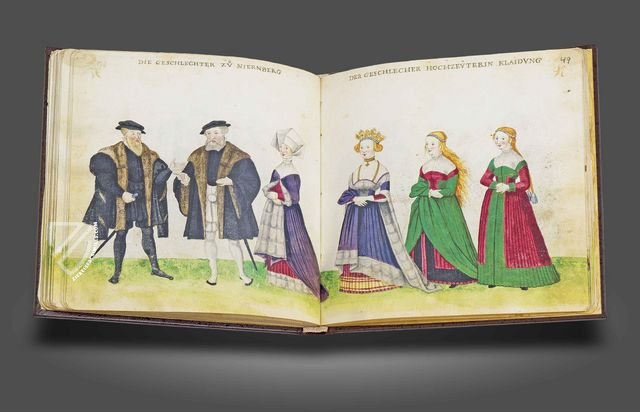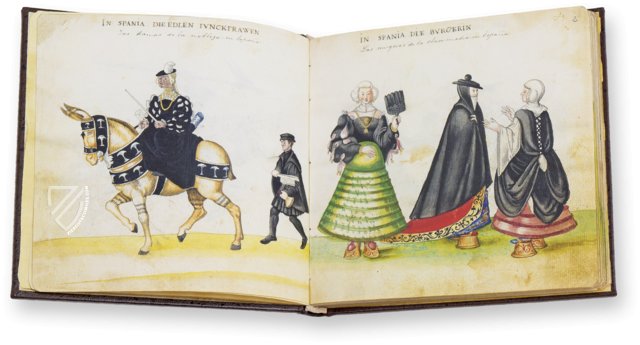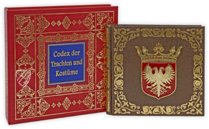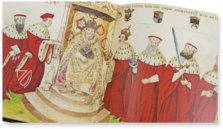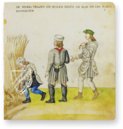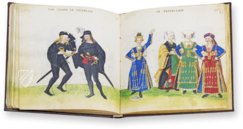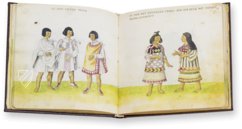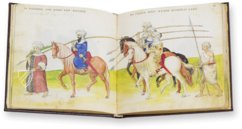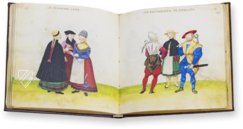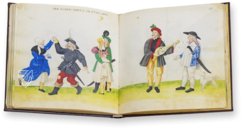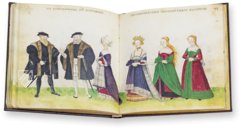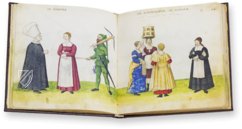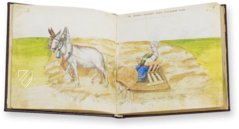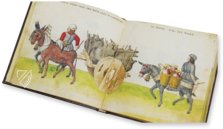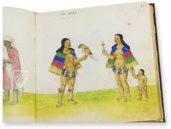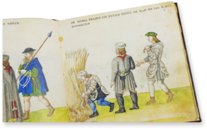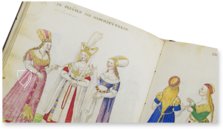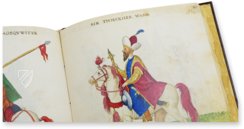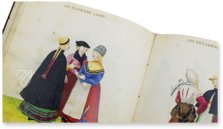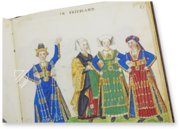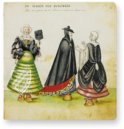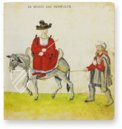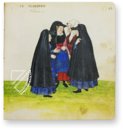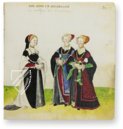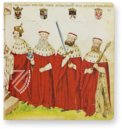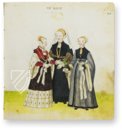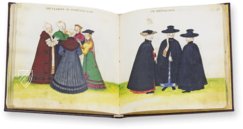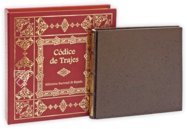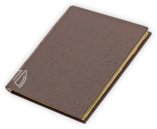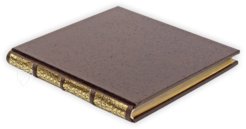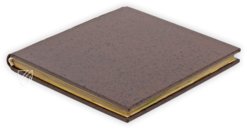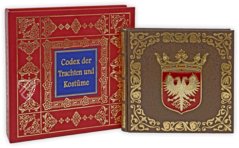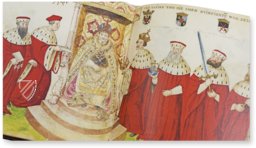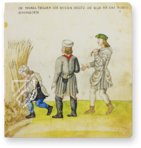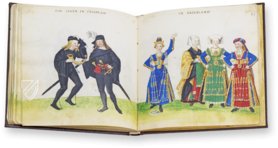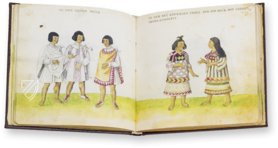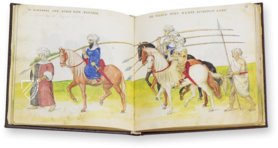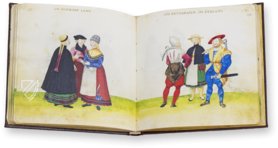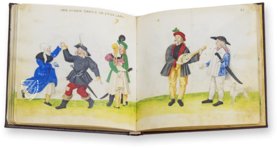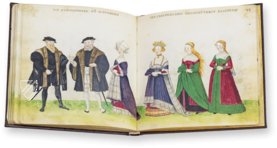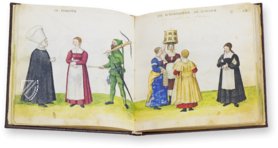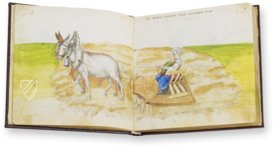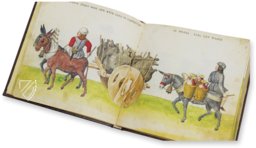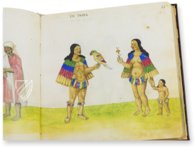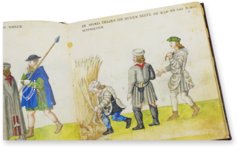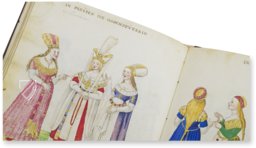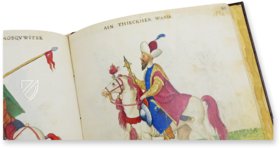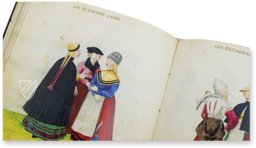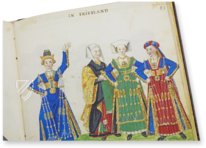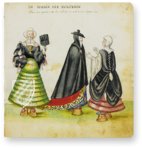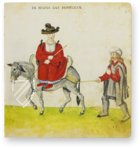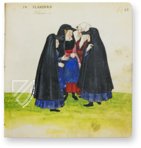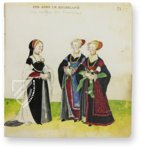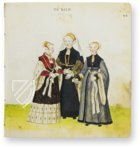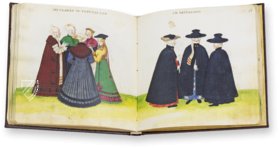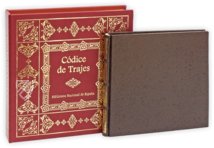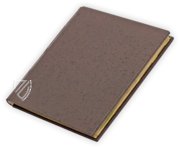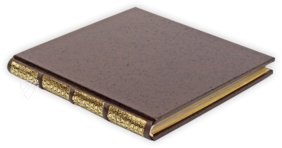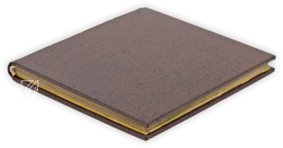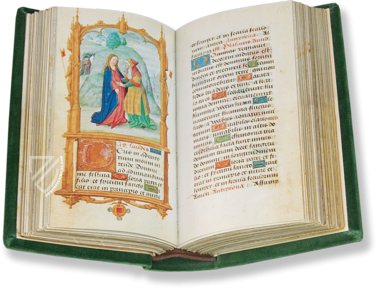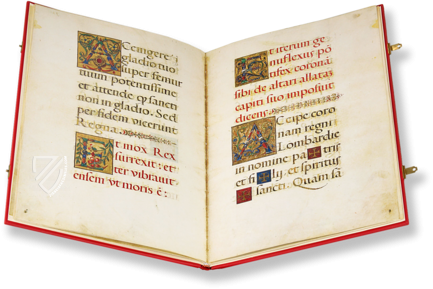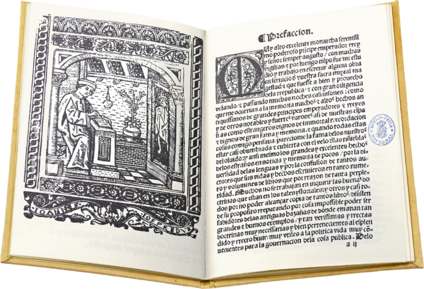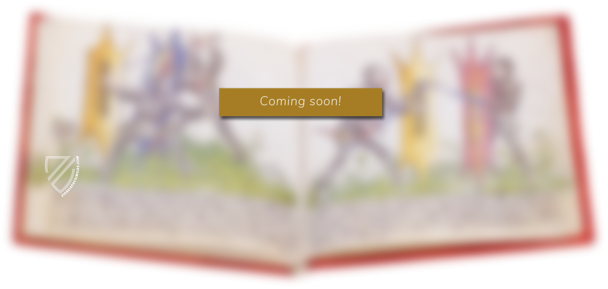Codex of Costumes
(3,000€ - 7,000€)
The Biblioteca Nacional de España has a significant German manuscript from the 16th century in its collection: the Códice de Trajes or “Codex of Costumes”. It was acquired by the Ministry of Culture from a private collection in December of 2010, and contains a repertoire of 125 illustrations of clothing using gouache watercolors. It depicts the manner of dress in Spain, some neighboring countries around the empire of Holy Roman Emperor Charles V (1500–58), and more faraway places such America and Africa. It has epigraphs in German and was made in an unknown artist’s workshop. Its great rarity and importance as a source of knowledge regarding the costumes and fashion at the time, as well as the charming beauty of its illustrations, make it an exceptional work.
Codex of Costumes
In 2010, the Spanish Ministry of Culture made an exciting and important acquisition: the Códice de Trajes or “Codex of Costumes”. It is a wonderfully illuminated witness to the reign of Holy Roman Emperor Charles V (1500–58), who ruled over the first empire over which the “sun never set”. It consists of 125 watercolors showing the style of dress in various regions around the world both in and near the massive Hapsburg Empire in Europe or the Spanish Empire in Africa and the New World, which were united under Charles V, who came closer than anyone since the Emperor Charlemagne to achieve the medieval concept of a universal monarchy uniting all of Christendom, the so-called res publica Christiana. Furnished with captions in German, the splendid manuscript from ca. 1546–7 is of inestimable value as a reference work concerning the customs and fashions of the period. Instead of parchment, the manuscript was creating using paper which, according to the watermark, was created in Augsburg in 1546.
An Irreplaceable Source of 16th Century Fashions
The 125 miniatures of this manuscript are a parade of Portuguese, Berbers, Indians, French, English, Turks, Tatars, Irish , Croats, and Hungarians, and also feature more detailed depictions of the peoples of Germany, Spain, and the Netherlands. Although it is not known who created the manuscript, the influence of various Northern Renaissance masters can be seen in this work such as Albrecht Dürer (1471–1528), especially with regard the dress of Nuremburg, Livonia, or among the Turks, as well as Albrecht Altdorfer (ca. 1480–1538) and Hans Burgkmair the Elder (1473–1531). Furthermore, there is evidence of the influence of the anonymous workshop on contemporary masters like Lucas Cranach the Elder (1472–1553), particularly in the miniature showing the emperor and seven prince-electors, or Lucas de Heere (1534–1584), whose image of a lancer on horseback from ca. 1570 is faithfully recreated from the opening page of the Codex of Costumes. Then again, both could be copies based on the same model. Georg Hoefnagel (1542–1601) also produced horse riders very similar to those in this manuscript for his famous Civitates Orbis Terrarum. Numerous other artists were influenced by the work including Jost Amman (1539–91) and Cesare Vecellio (ca. 1521 – ca. 1601).
An Artist’s Travelogue?
The manuscript at hand was created during the second half of Emperor Charles V’s reign during a time when fashion as we know it developed. Previously, clothing had simply been an expression of one’s station, but the increasing money supply of late medieval Europe resulted in a dramatic revolution in fashion that was so unsettling to the social order that it resulted in sumptuary laws. First appearing in the 13th century, sumptuary laws were meant to act as a moralizing influence intended to restrict people to their social class while also limiting public displays and the ruinous expenses that were being incurred by members of the wealthy classes madly pursuing the newest fashions. Practically speaking, they limited luxurious fabrics to the noble classes, but were ultimately ineffective. Although likely created in the imperial cities of Augsburg and Nuremberg, the miniatures may very well be based on sketches accumulated while accompanying the Emperor on his travels throughout Spain, Flanders, and Germany. The miniatures apparently originate from between 1513 and 1515 and were later transformed into widely-disseminated woodcuts in 1526.
Codicology
- Alternative Titles
- Buch der Kostüme
Códice de Trajes
Codex der Trachten und Kostüme - Type
- Manuscript on paper
- Size / Format
- 128 pages / 20.0 × 20.0 cm
- Origin
- Germany
- Date
- Ca. 1546–47
- Epochs
- Style
- Language
- Illustrations
- 125 gouache watercolors
- Content
- Contains a repertoire of clothing illustrations in gouache, from Spain, some neighbouring countries around Charles V Empire (Flanders, Germany…), and more faraway places such America and Africa.
Codex of Costumes
Harvesting Wheat
This wonderfully colored and naturalistic depiction of Spanish farmers shows them harvesting wheat that is almost as tall as they are. The man on the left is kneeling and using a sickle to harvest the grain, which he is piling on the ground. He is wearing blue tights and a grey coat with puffy sleeves, his head wrapped in a white cloth. A man wearing knee-high leather boots and wearing a large dagger with a gilded hilt in his belt looks on, perhaps the landowner or a foreman.
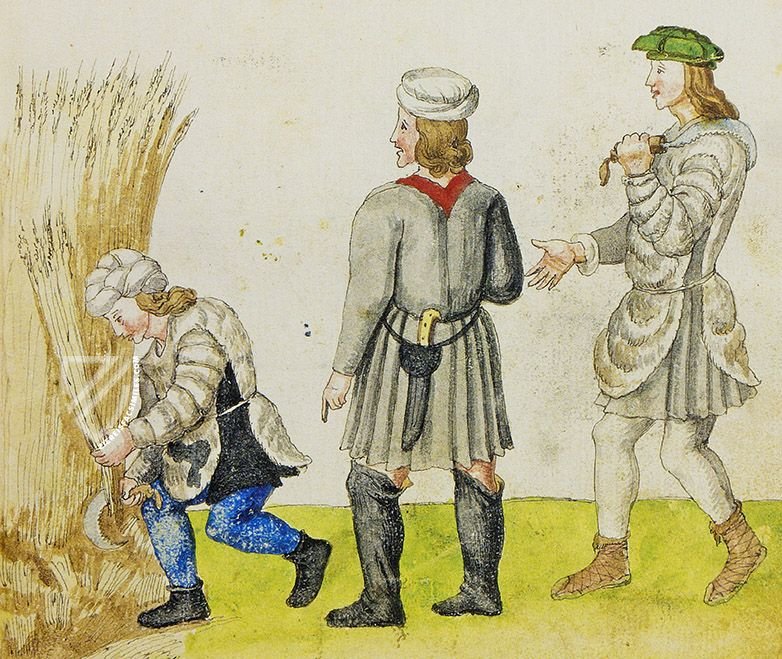
Codex of Costumes
Middle Class Spanish Women
The increasing size and importance of the urban middle class was one of the most important developments of late medieval Europe. Although lacking the power and position of the landed nobility, their great wealth allowed them to dress in the most expensive fashions. This depiction of three Spanish women gives a taste of how the wives of successful merchants or guildsmen might dress.
The two women on the right are dressed more conservatively with long black cloaks covering their elegant dresses, one with gold brocade and a long train. Holding a fan of black feathers, the woman on the left wears a green bell-shaped skirt and a black blouse with slits in the oversized sleeves that expose a layer of pink silk. All three figures wear platform shoes.
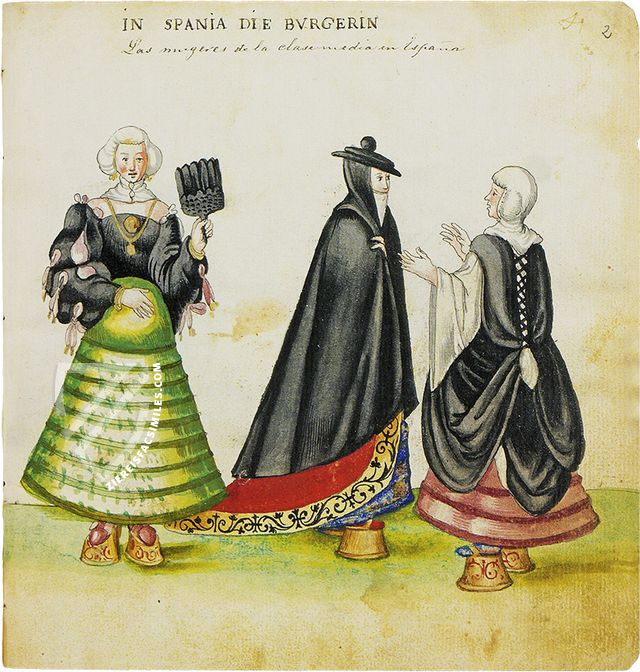
#1 Códice de Trajes
Language: Spanish
(3,000€ - 7,000€)
- Treatises / Secular Books
- Apocalypses / Beatus
- Astronomy / Astrology
- Bestiaries
- Bibles / Gospels
- Chronicles / History / Law
- Geography / Maps
- Saints' Lives
- Islam / Oriental
- Judaism / Hebrew
- Single Leaf Collections
- Leonardo da Vinci
- Literature / Poetry
- Liturgical Manuscripts
- Medicine / Botany / Alchemy
- Music
- Mythology / Prophecies
- Psalters
- Other Religious Books
- Games / Hunting
- Private Devotion Books
- Other Genres
- Afghanistan
- Armenia
- Austria
- Belgium
- Belize
- Bosnia and Herzegovina
- China
- Colombia
- Costa Rica
- Croatia
- Cyprus
- Czech Republic
- Denmark
- Egypt
- El Salvador
- Ethiopia
- France
- Germany
- Greece
- Guatemala
- Honduras
- Hungary
- India
- Iran
- Iraq
- Israel
- Italy
- Japan
- Jordan
- Kazakhstan
- Kyrgyzstan
- Lebanon
- Liechtenstein
- Luxembourg
- Mexico
- Morocco
- Netherlands
- Palestine
- Panama
- Peru
- Poland
- Portugal
- Romania
- Russia
- Serbia
- Spain
- Sri Lanka
- Sweden
- Switzerland
- Syria
- Tajikistan
- Turkey
- Turkmenistan
- Ukraine
- United Kingdom
- United States
- Uzbekistan
- Vatican City
- A. Oosthoek, van Holkema & Warendorf
- Aboca Museum
- Ajuntament de Valencia
- Akademie Verlag
- Akademische Druck- u. Verlagsanstalt (ADEVA)
- Aldo Ausilio Editore - Bottega d’Erasmo
- Alecto Historical Editions
- Alkuin Verlag
- Almqvist & Wiksell
- Amilcare Pizzi
- Andreas & Andreas Verlagsbuchhandlung
- Archa 90
- Archiv Verlag
- Archivi Edizioni
- Arnold Verlag
- ARS
- Ars Magna
- ArtCodex
- AyN Ediciones
- Azimuth Editions
- Badenia Verlag
- Bärenreiter-Verlag
- Belser Verlag
- Belser Verlag / WK Wertkontor
- Benziger Verlag
- Bernardinum Wydawnictwo
- BiblioGemma
- Biblioteca Apostolica Vaticana (Vaticanstadt, Vaticanstadt)
- Bibliotheca Palatina Faksimile Verlag
- Bibliotheca Rara
- Boydell & Brewer
- Bramante Edizioni
- Bredius Genootschap
- Brepols Publishers
- British Library
- C. Weckesser
- Caixa Catalunya
- Canesi
- CAPSA, Ars Scriptoria
- Caratzas Brothers, Publishers
- Carus Verlag
- Casamassima Libri
- Centrum Cartographie Verlag GmbH
- Chavane Verlag
- Christian Brandstätter Verlag
- Circulo Cientifico
- Club Bibliófilo Versol
- Club du Livre
- CM Editores
- Collegium Graphicum
- Collezione Apocrifa Da Vinci
- Comissão Nacional para as Comemorações dos Descobrimentos Portugueses
- Coron Verlag
- Corvina
- CTHS
- D. S. Brewer
- Damon
- De Agostini/UTET
- De Nederlandsche Boekhandel
- De Schutter
- Deuschle & Stemmle
- Deutscher Verlag für Kunstwissenschaft
- DIAMM
- Droz
- E. Schreiber Graphische Kunstanstalten
- Ediciones Boreal
- Ediciones Grial
- Ediclube
- Edições Inapa
- Edilan
- Editalia
- Edition Deuschle
- Edition Georg Popp
- Edition Leipzig
- Edition Libri Illustri
- Editiones Reales Sitios S. L.
- Éditions de l'Oiseau Lyre
- Editions Medicina Rara
- Editorial Casariego
- Editorial Mintzoa
- Editrice Antenore
- Editrice Velar
- Edizioni Edison
- Egeria, S.L.
- Eikon Editores
- Electa
- Emery Walker Limited
- Enciclopèdia Catalana
- Eos-Verlag
- Ephesus Publishing
- Ernst Battenberg
- Eugrammia Press
- Extraordinary Editions
- Fackelverlag
- Facsimila Art & Edition
- Facsimile Editions Ltd.
- Facsimilia Art & Edition Ebert KG
- Faksimile Verlag
- Feuermann Verlag
- Folger Shakespeare Library
- Franco Cosimo Panini Editore
- Friedrich Wittig Verlag
- Fundación Hullera Vasco-Leonesa
- G. Braziller
- Gabriele Mazzotta Editore
- Gebr. Mann Verlag
- Gesellschaft für graphische Industrie
- Getty Research Institute
- Giovanni Domenico de Rossi
- Giunti Editore
- Graffiti
- Grafica European Center of Fine Arts
- Guido Pressler
- Guillermo Blazquez
- Gustav Kiepenheuer
- H. N. Abrams
- Harrassowitz
- Harvard University Press
- Helikon
- Hendrickson Publishers
- Henning Oppermann
- Herder Verlag
- Hes & De Graaf Publishers
- Hoepli
- Holbein-Verlag
- Houghton Library
- Hugo Schmidt Verlag
- Idion Verlag
- Il Bulino, edizioni d'arte
- ILte
- Imago
- Insel Verlag
- Insel-Verlag Anton Kippenberger
- Instituto de Estudios Altoaragoneses
- Instituto Nacional de Antropología e Historia
- Introligatornia Budnik Jerzy
- Istituto dell'Enciclopedia Italiana - Treccani
- Istituto Ellenico di Studi Bizantini e Postbizantini
- Istituto Geografico De Agostini
- Istituto Poligrafico e Zecca dello Stato
- Italarte Art Establishments
- Jan Thorbecke Verlag
- Johnson Reprint Corporation
- Josef Stocker
- Josef Stocker-Schmid
- Jugoslavija
- Karl W. Hiersemann
- Kasper Straube
- Kaydeda Ediciones
- Kindler Verlag / Coron Verlag
- Kodansha International Ltd.
- Konrad Kölbl Verlag
- Kurt Wolff Verlag
- La Liberia dello Stato
- La Linea Editrice
- La Meta Editore
- Lambert Schneider
- Landeskreditbank Baden-Württemberg
- Leo S. Olschki
- Les Incunables
- Liber Artis
- Library of Congress
- Libreria Musicale Italiana
- Lichtdruck
- Lito Immagine Editore
- Lumen Artis
- Lund Humphries
- M. Moleiro Editor
- Maison des Sciences de l'homme et de la société de Poitiers
- Manuscriptum
- Martinus Nijhoff
- Maruzen-Yushodo Co. Ltd.
- MASA
- Massada Publishers
- McGraw-Hill
- Metropolitan Museum of Art
- Militos
- Millennium Liber
- Müller & Schindler
- Nahar - Stavit
- Nahar and Steimatzky
- National Library of Wales
- Neri Pozza
- Nova Charta
- Oceanum Verlag
- Odeon
- Orbis Mediaevalis
- Orbis Pictus
- Österreichische Staatsdruckerei
- Oxford University Press
- Pageant Books
- Parzellers Buchverlag
- Patrimonio Ediciones
- Pattloch Verlag
- PIAF
- Pieper Verlag
- Plon-Nourrit et cie
- Poligrafiche Bolis
- Presses Universitaires de Strasbourg
- Prestel Verlag
- Princeton University Press
- Prisma Verlag
- Priuli & Verlucca, editori
- Pro Sport Verlag
- Propyläen Verlag
- Pytheas Books
- Quaternio Verlag Luzern
- Reales Sitios
- Recht-Verlag
- Reichert Verlag
- Reichsdruckerei
- Reprint Verlag
- Riehn & Reusch
- Roberto Vattori Editore
- Rosenkilde and Bagger
- Roxburghe Club
- Salerno Editrice
- Saltellus Press
- Sandoz
- Sarajevo Svjetlost
- Schöck ArtPrint Kft.
- Schulsinger Brothers
- Scolar Press
- Scrinium
- Scripta Maneant
- Scriptorium
- Shazar
- Siloé, arte y bibliofilia
- SISMEL - Edizioni del Galluzzo
- Sociedad Mexicana de Antropología
- Société des Bibliophiles & Iconophiles de Belgique
- Soncin Publishing
- Sorli Ediciones
- Stainer and Bell
- Studer
- Styria Verlag
- Sumptibus Pragopress
- Szegedi Tudomànyegyetem
- Taberna Libraria
- Tarshish Books
- Taschen
- Tempus Libri
- Testimonio Compañía Editorial
- Thames and Hudson
- The Clear Vue Publishing Partnership Limited
- The Facsimile Codex
- The Folio Society
- The Marquess of Normanby
- The Richard III and Yorkist History Trust
- Tip.Le.Co
- TouchArt
- TREC Publishing House
- TRI Publishing Co.
- Trident Editore
- Tuliba Collection
- Typis Regiae Officinae Polygraphicae
- Union Verlag Berlin
- Universidad de Granada
- University of California Press
- University of Chicago Press
- Urs Graf
- Vallecchi
- Van Wijnen
- VCH, Acta Humaniora
- VDI Verlag
- VEB Deutscher Verlag für Musik
- Verlag Anton Pustet / Andreas Verlag
- Verlag Bibliophile Drucke Josef Stocker
- Verlag der Münchner Drucke
- Verlag für Regionalgeschichte
- Verlag Styria
- Vicent Garcia Editores
- W. Turnowski Ltd.
- W. Turnowsky
- Waanders Printers
- Wiener Mechitharisten-Congregation (Wien, Österreich)
- Wissenschaftliche Buchgesellschaft
- Wissenschaftliche Verlagsgesellschaft
- Wydawnictwo Dolnoslaskie
- Xuntanza Editorial
- Zakład Narodowy
- Zollikofer AG

